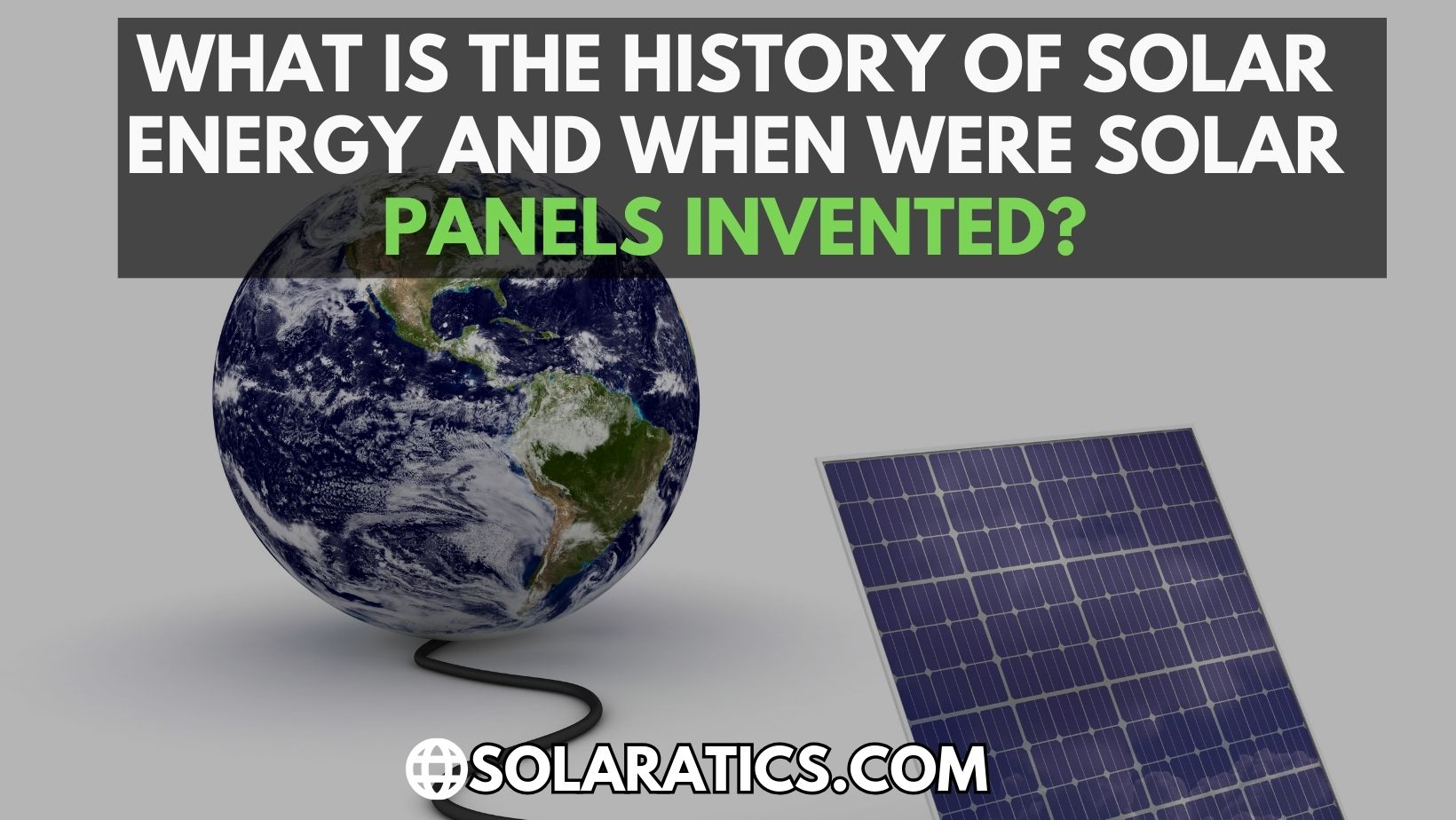History of Solar Energy & When Were Solar Panels Invented?

In recent years, solar power has emerged as one of the most promising renewable energy options. When compared to other energy sources, solar power has the greatest availability.
Solar power accounts for 20% of global energy production. In this brief article you will learn about the history of solar energy and when were solar panels invented for the first time ever.
All of Earth’s energy demands for an entire year may be met by the sun. There are several potential uses for solar-to-electricity conversion. The primary uses of solar energy are in residential, aerospace, and maritime contexts.

The practice of harnessing the power of the sun has a fascinating and long-standing history. Recognizing the sun’s potential, early cultures developed techniques to collect and store solar energy for later use. The origins of solar power are outlined here.
Solar Panels Invented
The evolution of solar panel technology was recursive and collaborative, requiring the work of many researchers. Exactly when they were first developed and who should receive credit for the idea are both points of contention.
This innovation, known as the “photovoltaic effect,” influenced subsequent PV advances using selenium.
William Grylls Adams and Richard Evans Day found out in 1876 that selenium generates electricity when exposed to sunlight, building on Willoughby Smith’s 1873 discovery of the element’s photoconductive potential.

Some historians credit Charles Fritts with the true creation of solar cells because he created the first solar cells in 1883 using selenium wafers.
However, silicon, not selenium, is used to create modern solar cells.
Therefore
The silicon photovoltaic (PV) cell was developed by Daryl Chapin and Calvin Fuller. Gerald Pearson at Bell Labs in 1954 is credited to some as the real inventor of solar panels.
In many people’s eyes, this is the moment that PV technology was truly born. As it was the first time that solar energy was used to reliably power electric equipment throughout the day.
The efficiency with which the first silicon solar cell converted sunlight was only 4% or less than a quarter of what current cells are capable of.
First Time Use of Solar Energy
Using magnifying glass-like materials to focus sunlight, humanity may have harnessed the sun’s rays as early as the seventh century B.C. Later.
In the third century B.C., the Greeks and Romans were said to have used mirrors to concentrate the sun’s rays to fuel torches used in religious rites.
These mirrors eventually became commonplace, and their name was changed to “burning mirrors.” Later, in the year 20 A.D., the Chinese recorded the usage of mirrors for the same reason.
Solar Energy In The 1800s
Edmond Becquerel, a 19-year-old French physicist, developed the photovoltaic phenomenon in 1839.
He discovered that an electric current could be generated by electrons in an excited state inside a conduction band that allowed them to freely flow through the material.
This, however, was not widely acknowledged until Einstein published a paper on solar power for which he later won the Nobel Prize in 1922. Charles Fritts developed the first solar panel in 1883 by covering selenium with a very thin layer of gold.
Only approximately 1% of the electrical potential was converted in the resultant cells. Because of this innovation, a new solar energy generation paradigm has emerged.

Solar Energy In The 1900s
In the 1950s, researchers at Bell Labs began developing photovoltaic (PV) technology and using silicon to create solar cells, ushering in the modern era of solar energy.
Daryl Chapin, Calvin Fuller, and Gerald Pearson, who achieved just a 4% efficiency, deserve credit for this development. As a result of this development, the United States government allocated greater resources to solar cell research.

Although solar panel production became feasible in the 1960s and 1970s. Technology was still too expensive for most people at the time. To lower the price of solar energy, researchers kept working on new technologies.
The first P-N junction cell was created after semiconductors gained popularity. And it all started with a mechanism described by Russel S. Ohl in 1941.
Ohl produced the first silicon solar cell by slicing the ingot into a top, barrier, and bottom part and connecting electrodes to the exposed surfaces. The first ever patented silicon PN junction Electromotive force (EMF) cell is seen in the image below.
Solar Energy In The 2000s
In the 1950s, fewer than a watt of solar cells were used to power electrical equipment around the world. Now in the 21st century, after 50 years of continual research and development of silicon and other PV materials.
Solar panels supply clean energy to millions of homes around the world, in addition to powering buildings and satellites.
Modern Solar Panel (1990s-2022)
Many companies in other regions of the world (mostly in East Asian countries) also spent the 1980s, 1990s, and 2000s developing utility-scale solar technology as interest in solar energy spread.

Manufacturing improvements and cost reductions in the solar industry over the years have made their products competitive in the household market.
Midway through the 2010s, however, solar panels entered the mainstream as their price dropped by nearly 90% over the decade. As a result, solar might graduate from research and development and become a practical energy option.
Look at the obvious connection between the growing number of solar installations and the falling price of solar energy. As of 2021, prices have leveled down a bit in response to unprecedented demand and strained supply systems.
In contrast, by the year 2021, renewables had already become the cheapest energy option worldwide.14 We don’t anticipate any additional decreases in the price of renewable energy sources like solar. But we do anticipate their increasing efficiency, practicality, and prevalence. Click here to know if your solar panel is working or not.
Solar Power’s Bright Future

Experts in the area can’t believe how quickly solar energy has progressed, and it looks certain to play a pivotal role in the next energy shift. There has been a compound annual growth rate of over 35% in the global PV business over the past decade.
As reported by the Solar Energy Business Association (SEIA). As the world’s energy mix shifts towards renewable sources, PV installation rates are certain to rise.
Over the past decade, panel module power has increased from 250 W to 500 W, reducing the module’s share of the entire PV system price. It will take time for newer solar cell generations to overtake the market share currently held by silicon solar cells.
The development of new, more cost-effective technologies for producing silicon wafer solar modules is one way to meet this problem and make solar energy more widely accessible.
This standardized sector is well-equipped to take on the challenge of producing several terawatts of power thanks to its focus on crystalline Silicon-based PV technology and its steep learning curve.

Single-junction solar cells have likewise reached their theoretical limit.
Tandem technologies have the potential to alleviate this issue. However, more study is needed to bring down the associated costs sufficiently for widespread use.
For a technology that’s been around for over half a century, there’s still a lot of uncharted territory that needs exploring.
Conclusion
From the 1990s to the present day, solar panels have seen considerable developments and improvements. The efficiency of solar panels has improved, their price has dropped, and new technologies and uses have arisen.
Thin-film solar panels, smart features, and solar cell incorporation into building materials have all increased the potential for solar energy production.
Solar energy is positioned to play a major part in the transition to a sustainable and clean energy future. As renewable energy becomes increasingly critical in battling climate change and fulfilling global energy demands.
Also Read: Off-Grid Hybrid Solar System Benefits & Maintenance: A Simple Guide OR What will be Your Average Monthly Electric Bill with Solar Panels In US
